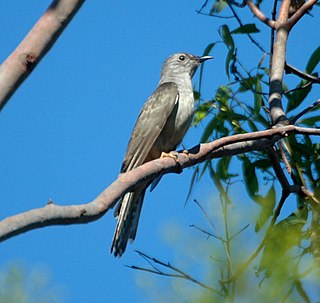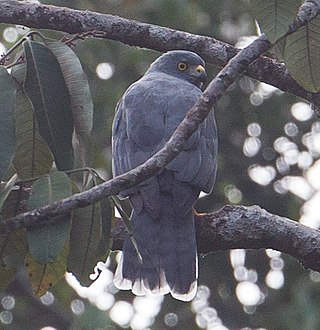
The Sahul brush cuckoo, formerly known as the brush cuckoo, is a member of the cuckoo family. It is native to Malesia, New Guinea, the Solomon Islands and northern and eastern Australia. It is a grey-brown bird with a buff breast. Its call is a familiar sound of the Australian and Indonesian bush.

The Moluccan goshawk or Halmaheran goshawk is a species of bird of prey in the family Accipitridae. This species was formerly placed in the genus Accipiter. It is endemic to Halmahera, Indonesia. Its natural habitats are subtropical or tropical moist lowland forest and subtropical or tropical moist montane forest.

The chestnut-breasted cuckoo is a species of cuckoo in the family Cuculidae. It is found in Australia, Indonesia, and Papua New Guinea. Its natural habitats are subtropical or tropical dry forests and subtropical or tropical mangrove forests.

The fan-tailed cuckoo is a species of cuckoo in the family Cuculidae. It is found in Australia, Fiji, New Caledonia, New Zealand, New Guinea, Solomon Islands, and Vanuatu.

The Sunda brush cuckoo is a species of cuckoo in the family Cuculidae. It is found in Indonesia, Malaysia, the Philippines, Singapore, and Thailand. Its natural habitat is subtropical or tropical moist lowland forests.

The bay coucal is a species of cuckoo in the family Cuculidae. It is endemic to Indonesia.
The short-toed coucal is a species of cuckoo in the family Cuculidae. It is found in Brunei, Indonesia, Malaysia, and Thailand. Its natural habitats are subtropical or tropical moist lowland forest and subtropical or tropical moist shrubland. It is threatened by habitat loss.

The dwarf cuckoo is a tropical American bird species of the cuckoo family (Cuculidae).
The red-capped coua is a species of cuckoo in the family Cuculidae. It is endemic to northwest Madagascar.

The Moluccan starling is a species of starling in the family Sturnidae. It is endemic to Indonesia.

The Moluccan owlet-nightjar, also known as the long-whiskered owlet-nightjar, is a species of bird in the family Aegothelidae. It is endemic to the northern Moluccas.

The lazuli kingfisher is a species of bird in the family Alcedinidae. It can be found on the islands of Seram, Ambon and Haruku. Found singly and in pairs in lowland wooded areas, including cultivated areas and mangroves. Pale blue underside is unique among kingfishers in its limited south Moluccan range. Rowdy vocalizations include repetitive “ker-chick” series and “ki-ki-ki-ki…” calls. It gets its name due to its colour being reminiscent of Lapis Lazuli.
The Sula cicadabird, also known as the Sula cuckooshrike or Moluccan graybird, is a species of bird in the family Campephagidae. It is endemic to Indonesia.

The Wallacean drongo or Greater Wallacean drongo is a species of bird in the family Dicruridae. It can be found in the countries of Indonesia and East Timor. It was formerly considered to be conspecific with the hair-crested drongo.

The spectacled monarch is a species of bird in the family Monarchidae. It is found in Australia, Indonesia, and Papua New Guinea. Its natural habitats are subtropical or tropical moist lowland forests, subtropical or tropical mangrove forests, and subtropical or tropical moist montane forests.

The Moluccan flycatcher or dark-grey flycatcher is a species of bird in the family Monarchidae. It is endemic to Indonesia.

The Wakolo myzomela is a species of bird in the family Meliphagidae. It is endemic to Indonesia, where it occurs in the Moluccan Islands of Buru and Seram. Its natural habitats are subtropical or tropical moist lowland forests, subtropical or tropical mangrove forests, and subtropical or tropical moist montane forests.
The Halmahera swiftlet or Moluccan swiftlet is a species in the family Apodidae. It is endemic to North Maluku, Indonesia.
The South Moluccan pitta is a species of pitta. It was formerly considered a subspecies of the red-bellied pitta. It is endemic to Indonesia where it occurs on Buru and Seram. Its natural habitat is subtropical or tropical moist lowland forests. It is threatened by habitat loss.

The North Moluccan pitta is a species of the pitta. It was considered a subspecies of the red-bellied pitta. It is endemic to Indonesia where it occurs on the northern Moluccas. Its natural habitat is subtropical or tropical moist lowland forests. It is threatened by habitat loss.
















